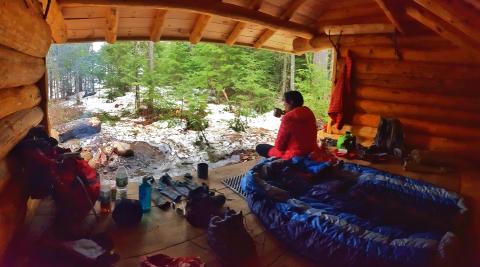Winter Camping
Winter camping in New York's Adirondacks can be addicting. Beautiful landscapes. Once-in-a-lifetime sunrises. Pure solitude in nature. It can all be yours to experience with a little advance planning.
If you're a newbie to winter camping in the Adirondacks, then expert instruction is what you need. Each January, the Adirondack Mountain Club hosts the ADK Winterfest at Heart Lake, with ski clinics and outdoor skills workshops at the Adirondack Loj outside Lake Placid. Can't make it? The club's Winter Mountaineering School – mentioned earlier – also pairs students with local guides on a winter day hike, weekend overnight, and a week-long trip that includes an ascent of a 4,000-footer.
Or visit Keene Valley in January, when the Mountaineer gear shop hosts Mountainfest. Get winter camping tips from guides and hear stories from pro athletes. Then practice what you learned with day trips from a reliable winter basecamp like Camp Peggy O'Brien or Grace Camp, cabins for rent near Johns Brook Lodge. After day trips in bitter, winter cold, return to propane heat, a soft bunk, and make hot meals from the camp kitchen. Ease into it. If you don't want to take full responsibility for your winter camping excursion in the Adirondacks, consider bunking it in a basecamp cabin.

The first thing to know is that camping in winter in the Adirondacks demands real skill and mountain savvy just to remain comfortable. It also requires planning and the right gear, clothing and equipment such as GPS technology. So why do people invest in camping during the winter? Because the experience including the snow-covered views glittering under a rising sun, the snowshoeing, and campfire-cooked meals is unlike any other experience you'll have in your life.
Winter temperatures dip as low as negative 30 in some places in the Adirondacks. While we do not recommend going winter camping in negative temps, or even temps below 20 degrees Fahrenheit, this does help freeze lakes and ponds, making remote areas easier to access. How do you know if the body of water is frozen enough? Experts recommend staying off any ice where there's flowing water underneath – so no go for rivers and streams – and that ice should be four or more inches thick to truly support your weight, and the weight of all the snow laying over its surface. Bring an ice auger to check the ice as you go because ice is rarely uniformly thick. And remember not all ice freezes equally. Clear ice is stronger than bubbly ice.
Don't go winter camping alone. Aside from the benefits of traveling with a buddy, you'll have someone to share the experience with, and someone who can keep an extra eye on conditions and your personal well-being. Buddy system it when you go winter camping in the Adirondacks.
Ease into it. Mother Nature is not someone to mess with, especially during winter in upstate New York. Test your limits first with a day trip so you can better understand your gear, how you layer and dress for the weather, how to stay warm, and conditions to look for and those to avoid. Plan to cook a meal outside so you have practice building a fire and feeding yourself. Doing this a couple of times will help you anticipate the unanticipated – the breakthroughs on partially frozen streams, the wet boots, the sweaty base layers – and change your approach accordingly.
For clothing, we always recommend not wearing cotton. Wool and wool blends are best for base layers. Waterproof winter boots with removable inserts are essential.
Avalanches are real and knowing the basics of avalanche safety is a necessary precaution. Rather than outline the different types of avalanches, we're going to let Princeton University do the honors. Find out all you ever wanted to know about avalanches.
Bring enough to eat and drink. A higher calorie intake in cold weather is essential for keeping your body functioning and maintaining a proper body temperature. DO NOT EAT SNOW! It takes a lot of energy for your body to melt snow and you're burning enough calories staying warm. If you run out of water, melt snow or ice over your heat source. Purify it before drinking or cooking with it.
Speaking of body temperature – your sleeping bag needs to be rated to at least 20 degrees below zero.
Lastly, to enjoy winter camping safely, you need to be in good physical shape. Sounds silly, but it's a good reminder that you need to be able to navigate terrain for a few miles, set up camp, and get yourself back out. According to the ADK Winter Mountaineering School handbook, you should be able to run 5 miles or hike 10 miles over hilly terrain and feel good the next day. Not the case? Time to whip yourself into shape!
Check out the ADK Winter Mountaineering School Handbook for essential tips to keep you safe, healthy and happy on your winter camping adventures.
The Adirondacks is a place of incredible scenic beauty and year-round outdoor recreation. Because of this, you can find a guide service to ensure you have fun, stay safe, and experience winter camping in the Adirondacks at its best.
Guide services are located throughout the region. Find an experienced Adirondack guide and get planning!